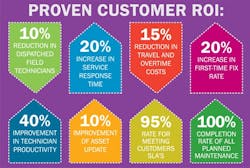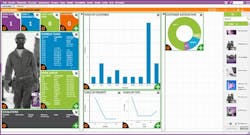Inside the four walls of a plant, maintenance management processes are well suited to standard asset management (EAM/CMMS) software. But for geographically dispersed work, greater coordination, collaboration, and information mobility is required.
Most companies have at least a first-generation system in place to handle field service scheduling, dispatch, service parts management, and perhaps some degree of mobility. Others use EAM/ERP system extensions for more robust scheduling and dispatch capabilities. The worst-case scenario is management by spreadsheets and manual processes, which hamper productivity and drive excessive costs.
An increasingly popular solution is purpose-built field service management (FSM) software that automates and streamlines the complete service process, provides connected and disconnected mobility, and integrates with the installed EAM/ERP system.
Highly distributed operations such as refineries, pulp and paper, mining, and transportation are obvious candidates for this approach, as field work is fundamental to their business model. Their assets and equipment are situated across wide geographic areas and require efficient condition monitoring, inspections, testing, repairs, and installation. Similarly, OEMs and third-party service providers require mobility in the delivery of point skills, specialized services, and domain expertise to remote customer sites and assets.
The utilities industry is a prime example. “Field service is pervasive in utilities. Mobility is necessary for inspection, maintenance and emergency work, as well as short-cycle work, long-cycle projects, and customer appointments. Paperwork puts a drag on the processes,” says Jill Feblowitz, owner of Feblowitz Energy Consulting.
FSM software is unique in several respects. Following are its top 10 advantages:
1. Automation: FSM software automates in a very streamlined fashion those activities that occur outside the four walls. From its robust planning and scheduling capabilities to providing the ability to adapt to changes throughout the day, it avoids the frustration and cost of wasted time and inefficient activities.
Consider, for example, the installation of a large CNC machine. A precise sequence of events is required: a subcontractor pours the footings; electrical personnel run the power; an install technician arrives as the equipment is delivered, installs it to the power grid, and tests its basic capabilities; software specialists configure the electronics; trainers teach the end users how to use the machine; and finally the machine is transitioned to support.
FSM software facilitates this type of task coordination with a dynamic scheduling engine that handles all the various planning and scheduling variables and dependencies. It takes the decisions out of the hands of a manual dispatch environment and puts them into the software.
[sidebar id="5"]
Another example is automated cost management and invoicing, as the actual service labor and associated costs are recorded instantly. FSM software also knows which service is under warranty, and whether there are any special pricing considerations such as a pre-negotiated labor rates or parts discounts. The software drives billing speed and accuracy, removing that burden from the technician.
2. Resource optimization: The assignment and routing of field personnel is optimized with FSM software, which is important because this can directly affect profitability. “Dispatch optimization allows crews to do as many jobs in a day as possible. It minimizes drive time, increases productivity, and reduces emissions and fuel charges,” says Feblowitz.
For example, Source Refrigeration & HVAC replaced its manual dispatch processes with an automated FSM system in order to create more efficient routes. In one region alone, service technician travel times were reduced by 35% while maintaining service level compliance. “Instead of someone calculating this information in their heads, we needed a system to determine the plan in a uniform way across all sites,” recalls Hal Kolp, vice president of information technology at Source Refrigeration & HVAC.
FSM software facilitates crew selection by pushing visibility into skill sets, certifications, union work classifications, proximity, time commitments, overtime, contracted service levels, penalties for noncompliance, and other crucial factors.
3. Coordination: FSM software simplifies management of the complete field service life cycle, including the equipment, work orders, labor, service parts, warranties, returns, contracts, and projects.
For example, before implementing FSM software, oil and gas engineering services company T H Hill struggled with a lack of coordination. Every step in managing a resource, from dispatch to reporting and the invoicing of the customer, was a disparate process with no standard workflows, controls, or database. “These were insurmountable problems without adding a better and consolidated tool,” explains Scott Harrison, CFO at T H Hill. Its FSM solution solved these concerns: the company attributes its 38% revenue growth in 2011, and 34% in the first seven months of 2012, to the FSM solution.
4. Efficiency: With FSM software, when technicians are dispatched to a job, the task is sent to their mobile device along with the most efficient route to the site, parts and tools required, service history, contacts, applicable warranties and contractual commitments – everything needed to deliver timely and effective service.
As the work is performed, the tasks are checked off on the mobile device, keeping planners and managers informed of the current status. The technicians can also record service notes, diagnostics, test results, quality information, parts consumed and labor expended in the device, and capture as found/as left images or video using their mobile device.
“There are a lot of efficiencies yet to be gained, especially in power outage situations where there is still a lot of paper-based activity. Quick, safe resolution is required to maintain customer satisfaction,” suggests Feblowitz.
Equipment returns, refurbishments, depot repairs, and reverse logistics also are properly tracked and managed in an FSM solution. For instance, the software reveals when it is more cost effective to return equipment for replacement or repairs rather than dispatching an engineer to the field. Additionally, accurate parts dispositions ensure that refurbished equipment is not scrapped or overlooked.
5. Responsiveness: Lacking an intelligent FSM solution puts companies in a reactive state to inevitable changes. Situations in the field change rapidly throughout the day, causing static work plans to degrade as soon as they are generated. Necessary parts or skill sets may be missing, or union rules may require an additional crew member. Travel time to the site or the work duration may take longer than planned, the weather may not cooperate, the technician may fall ill, or a higher-priority task may arise.
The primary downside of a manual approach is the absence of real-time, tethered or untethered mobile communication with the field staff, leaving them unable to effectively deal with surprises. With FSM software and mobile devices offering real-time, two-way communication, schedulers and service teams can respond quickly to dynamic circumstances and alert the customer, reorganize priorities, and address any shortfalls from the field.
6. Accuracy: Consolidating all FSM activity in a single tool promotes greater data and decision accuracy. For example, the tracking of inventory in the service supply chain is more precise with FSM software. Parts are recorded as they are taken from stock and also when acquired from supply houses or colleagues nearby. This encourages optimal parts placement and inventory levels, and drives supply house relationship improvements.
It also facilitates work planning. “Some utilities have their work planned out so well that visits to the warehouse are infrequent. Field employees will load on the truck all the job packages needed for the week, and seldom have to return for additional equipment,” says Feblowitz.
7. Oversight: When GPS tracking is enabled, oversight of field workers is improved. GPS provides validation of their precise geographic location, distance from the job site, and actual time of arrival. It can also alert when the worker travels outside of a prescribed area.
Regulatory compliance is also facilitated due to the structure and consistency afforded by FSM software. From their mobile device, field users can access and transmit required regulatory information and fulfill documentation requirements, avoiding the fines and other costs of nonconformance.
8. Usability: The usability of role-based FSM software stands in stark contrast to ERP solutions, which are generalized and cumbersome with high functional and administrative overhead. For instance, in one ERP system, upwards of 14 windows are accessed to add a service part. FSM software also compares favorably to error-prone manual and spreadsheet processes that create information silos and cause dual entry.
Users of ERP systems with limited field service capabilities also lack optimal agility. Though ERP systems can be programmed to do almost anything, it comes at the cost of flexibility and responsiveness.
Figure 2. ROI from FSM software is quantifiable, as these examples suggest. (Source: IFS)
9. Scalability: As service processes and technologies become more sophisticated and field service teams get larger, keeping the administration cost structure and profit margin intact becomes more urgent. This is where field service automation has its greatest payback. FSM software mitigates the complexity of meeting growing customer demands and aggressive service delivery levels, and balances all the moving parts that go into deploying field personnel to complete service work.
10. Flexibility: With modern FSM solutions, customers can choose the deployment model that makes the best business sense for their organization. Traditionally, enterprise software was self-hosted on the premises. Today, companies can avoid or reduce their upfront capital expenditures with a cloud-based option – whether licensing the FSM application on a subscription basis, or opting for a fully managed cloud with all software and hardware hosted externally, and only the data managed on the premises.
Device flexibility is another advantage. FSM software is either device specific or device agnostic. Device-specific FSM software, written to support Apple iOS, Android and/or Windows mobile platforms, can take advantage of capabilities provided by the given platform. Examples include real-time, turn-by-turn mapping, GPS tracking, and cameras to capture photographs or videos of conditions found and left on site.
Figure 1. FSM software presents real-time, role-based information in an easy-to-understand graphical view. (Source: IFS)




